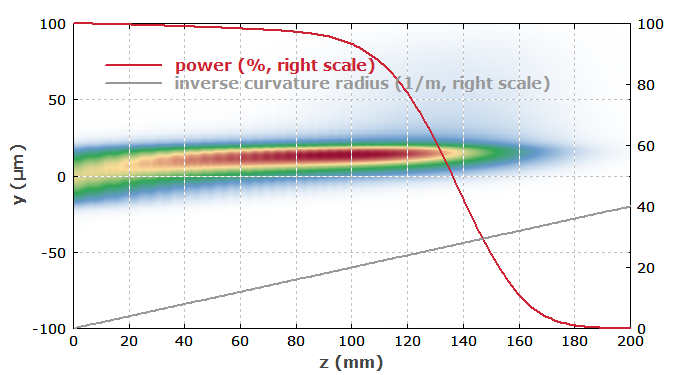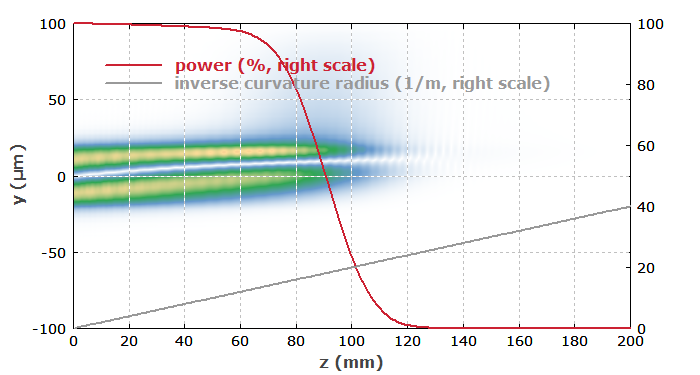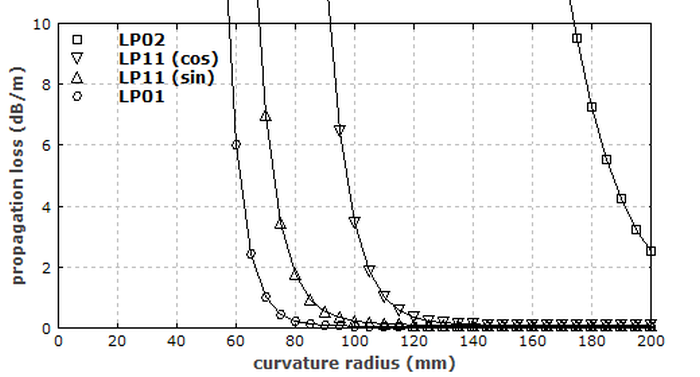
RP Fiber Power – Simulation and Design Software
for Fiber Optics, Amplifiers and Fiber Lasers
| Overview | Features | Speed | Model |
| Data | Interface | Demos | Versions |
Example Case: Bending of a Large Mode Area Fiber
Here we show how RP Fiber Power can be used to analyze bend effects in fibers.
Description of the Model
We consider a fiber with a simple step-index design: a core radius of 20 μm and a low numerical aperture of 0.05. At a wavelength of 1 μm, that design supports several guided modes, but one can try to operate it with the fundamental mode only.
For the beam propagation, we use a relatively large grid and simulate losses for cladding modes as an absorption which increases steeply with increasing distance from the core.
The script code to set up the beam propagation is shown here:
; Grid parameters for beam propagation:
r_max := 100 um
N := 2^7
dr := 2 * r_max / N
z_max := 200 mm
dz := 100 um
N_z := z_max / dz
N_s := 5
loss(x, y) := 1e2 * ((x^2 + y^2) / (40 um)^2)^4
calc { set up the beam propagation }
begin
bp_set_grid(r_max, N, r_max, N, z_max, N_z, N_s);
bp_define_channel(lambda);
bp_set_n('n_f(sqrt(x^2 + y^2))'); { index profile }
bp_set_R('R(z)', '');
bp_set_loss('loss(x, y)'); { simulate losses for cladding modes }
bp_set_A0('A_lm_xy(0, 1, lambda, x, y)'); { initial amplitude }
bp_set_interpol(2); { quadratic interpolation }
end
Results
Initially, we assume that the bending becomes tighter and tighter along the length of the fiber. The launched light is entirely in the fundamental mode. We then let the inverse curvature radius increase linearly with the distance. Figure 1 shows the amplitude distribution in the y-z plane.

One can see that the intensity profile of the guided mode is more and more pushed away from the fiber axis, and that the optical intensity rises due to a reduction in mode area. After 100 mm, the mode area is only about half the original mode area. From that point on, the losses become quite large: light is more and more coupled out into cladding modes. We see that the bend losses become critical when the bend radius reaches the order of 50 mm.
We can do the same for the LP11 mode, see Figure 2. Here, the bend losses set in earlier, and basically all power is lost already after 120 mm.

It is also of interest to investigate the bend losses (in dB/m) for different modes as a function of curvature radius. Instead of doing separate simulation runs for each radius and mode, we can do a single automated simulation. For each parameter set, we let the curvature radius be adjusted smoothly and let the field propagate over some distance, so that the steady state is approximately reached. Then we propagate further over some distance in order to obtain the propagation loss. This takes several minutes, but we get a lot of data:

